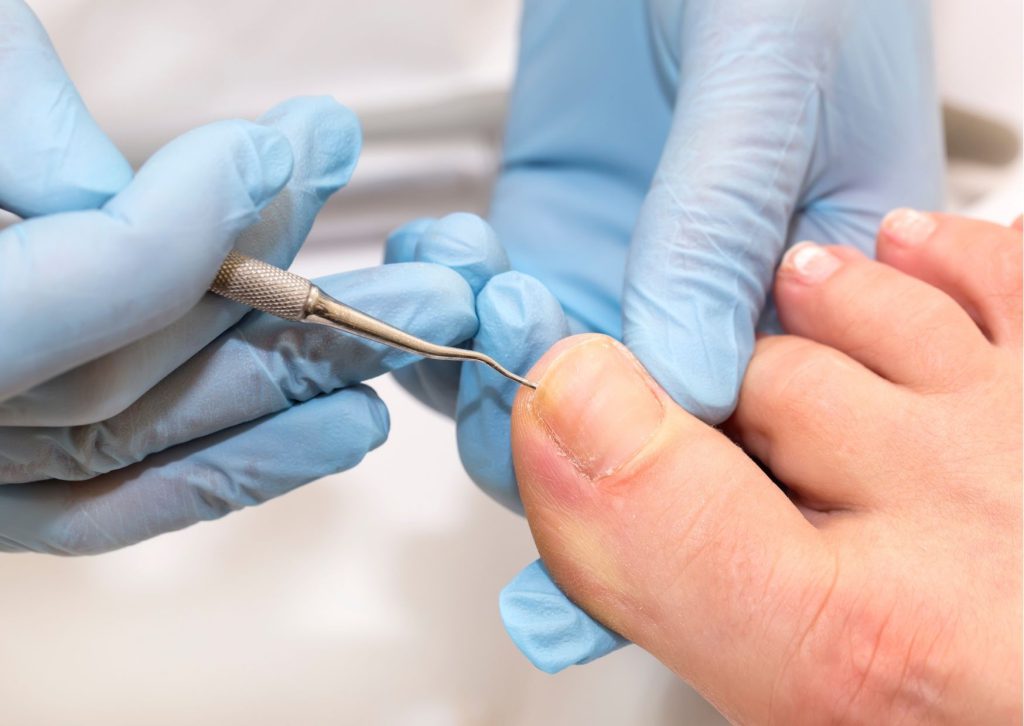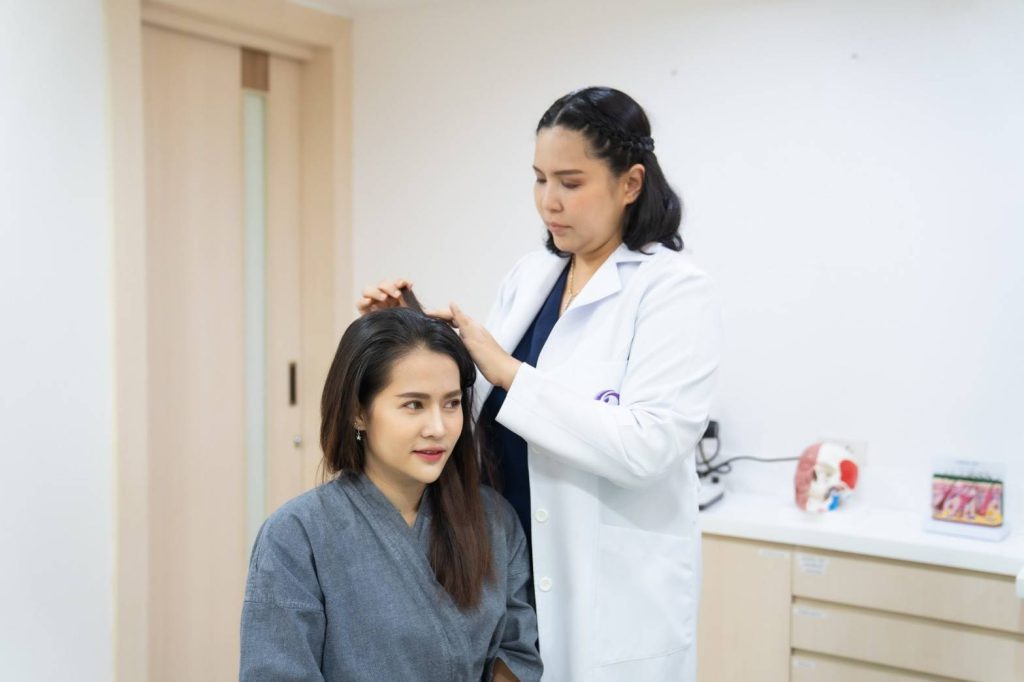Reviews a nail treatment clinic recommended in Chiang Mai
Nail disease is a broad term used to describe any condition or disorder that affects the nails on the hands or feet. Some common nail diseases include fungal nail infections, psoriasis, eczema, and nail dystrophy.
Fungal nail infections are one of the most common nail diseases, characterized by thick, discolored, and brittle nails. They are caused by an overgrowth of fungi in or under the nail, and can be difficult to treat without medical intervention.
Ingrown toenail disease
Ingrown toenail disease is a condition where the edge of the toenail grows into the surrounding skin, causing pain, redness, swelling, and in some cases, infection. It most commonly affects the big toe, but can also occur in other toes.
Ingrown toenails can be caused by a variety of factors, including improper trimming of the nails, wearing tight or ill-fitting shoes, injury to the toe, and genetic predisposition. People with diabetes or other medical conditions that affect circulation may be at a higher risk of developing ingrown toenails.
Causes of Ingrown Toenail Disease
Ingrown toenail disease can be caused by several factors, including:
1. Improper nail trimming Cutting the toenail too short or rounding the edges can cause the nail to grow into the skin.
2. Trauma Injury to the toe, such as stubbing it or dropping something on it, can cause the toenail to grow into the skin.
3. Genetics The shape and curvature of the toenail may be inherited, making some people more prone to developing ingrown toenails.
4. Footwear Wearing shoes that are too tight or narrow can put pressure on the toenail and cause it to grow into the skin.
5. Foot structure People with flat feet or other foot abnormalities may be more susceptible to ingrown toenails.
6. Poor hygiene Ingrown toenails can develop as a result of poor foot hygiene, such as not washing the feet regularly or wearing dirty socks.
7. Medical conditions Certain medical conditions, such as diabetes or peripheral vascular disease, can affect circulation to the feet and increase the risk of ingrown toenails.
Infected nail disease
Infected nail disease is a condition that occurs when bacteria, fungi, or viruses enter the nail bed and cause an infection. This can lead to a variety of symptoms, including redness, swelling, pain, and discolored nails. In some cases, infected nail disease can also cause the nail to thicken or become distorted.
Symptoms of Infected Nail Disease
Symptoms of an infected nail disease can vary depending on the specific condition, but some common signs include:
- Discoloration: The affected nail may become yellow, brown, or green.
- Thickening: The nail may become thicker and more difficult to trim.
- Change in nail shape: The nail may become distorted or misshapen.
- Foul odor: The nail may emit a strong, unpleasant odor.
- Pain or discomfort: The nail and surrounding skin may be tender, painful, or itchy.
- Swelling or redness: The skin around the nail may become swollen, red, or inflamed.
- Pus or discharge: If the infection is severe, pus or other fluid may drain from the affected nail.
- Separation of the nail from the nail bed: The nail may become detached from the skin underneath it.
Ingrown toenail disease is a condition where the edge of the toenail grows into the surrounding skin, causing pain, redness, swelling, and in some cases, infection. It most commonly affects the big toe, but can also occur in other toes.
Ingrown toenails can be caused by a variety of factors, including improper trimming of the nails, wearing tight or ill-fitting shoes, injury to the toe, and genetic predisposition. People with diabetes or other medical conditions that affect circulation may be at a higher risk of developing ingrown toenails.
Curved nail disease
Curved nail disease, also known as nail clubbing or digital clubbing, is a condition where the fingertips and nails become enlarged and the nails curve downward. It’s a sign of an underlying medical condition, rather than a disease in and of itself. Symptoms of curved nail disease may include thickening and rounding of the fingertips, an increased angle between the nail and the nail bed, and softening and flattening of the nail plate. Treatment of curved nail disease involves addressing the underlying medical condition. If the condition is related to lung or heart disease, treatment may involve medication, oxygen therapy, or surgery. If the condition is related to a digestive or liver condition, treatment may involve dietary changes or medication.
Symptoms of Curved Nail Disease
1. Thickening of the fingertips The fingertips may become swollen or bulbous in appearance.
2. Curved nails The nails may curve downward instead of growing straight out from the nail bed.
3. Changes in nail texture The nails may become thicker and harder, with a shiny or glossy appearance.
4. Loss of the normal angle between the nail and the nail bed The angle between the nail and the nail bed may become greater than normal.
5. Softening of the nail bed The nail bed may become soft and spongy.
6. Flattening of the nail plate The nail plate may become flatter and wider than usual.
If you have treated nails What are the dangers of making a mistake?
If you have treated nails, making a mistake can have several dangers, depending on the type of treatment and the mistake made. Some potential risks include:
1. Infection
If proper hygiene and sterilization techniques are not followed during the treatment, it can lead to infections such as bacterial or fungal infections.
2. Nail damage
Incorrect nail trimming or filing can damage the nail plate or the surrounding skin, leading to pain, discomfort, and even permanent damage.
3. Allergic reactions
Certain nail products, such as acrylic or gel nails, can cause allergic reactions in some people. If proper precautions are not taken or if the products are applied incorrectly, it can lead to an allergic reaction.
4. Chemical exposure
Nail treatments often involve the use of chemicals such as acetone, which can be harmful if inhaled or absorbed through the skin.
5. Pain or discomfort
If the treatment is performed improperly or with too much force, it can cause pain or discomfort during and after the treatment.
Hair disease
Hair disease is a general term used to describe any condition or disorder that affects the hair on the scalp, face, or body. There are many different types of hair diseases, each with their own causes, symptoms, and treatments.
Some common hair diseases include:
1. Alopecia
A condition that causes hair loss, which can be temporary or permanent and can occur in various patterns.
2. Dandruff
A common scalp condition that causes flaking and itching, often due to an overgrowth of yeast on the scalp.
3. Hirsutism
A condition that causes excessive hair growth in women, often on the face, chest, or back, due to hormonal imbalances.
4. Folliculitis
An infection or inflammation of the hair follicles, which can cause pimples, redness, and itching on the scalp.
5. Trichotillomania
A compulsive disorder that causes people to pull out their own hair, often leading to bald patches or hair loss.
6. Tinea capitis
A fungal infection of the scalp that causes hair loss, scaling, and itching.
Treatment for hair diseases depends on the underlying cause and the specific condition. Options may include medications, topical treatments, lifestyle changes, or surgical intervention. It’s important to seek medical attention if you are experiencing symptoms of a hair disease, as early diagnosis and treatment can often lead to better outcomes.
Skin disease
Skin disease refers to any condition or disorder that affects the skin, which is the largest organ in the human body. There are numerous skin diseases, each with their own causes, symptoms, and treatments.
Some common skin diseases include:
1. Acne
A skin condition that causes pimples, blackheads, and whiteheads due to the clogging of hair follicles with oil and dead skin cells.
2. Eczema
A chronic condition that causes dry, itchy, and inflamed skin, often due to an overactive immune system.
3. Psoriasis
A chronic condition that causes scaly, red patches on the skin, due to an overproduction of skin cells.
4. Rosacea
A skin condition that causes redness and small, pus-filled bumps on the face, often triggered by certain foods or environmental factors.
5. Dermatitis
An inflammation of the skin that can be caused by irritants, allergens, or other factors.
6. Skin cancer
A type of cancer that affects the skin, often caused by prolonged exposure to the sun or other sources of ultraviolet radiation.
Treatment for skin diseases depends on the underlying cause and the specific condition. Options may include medications, topical treatments, lifestyle changes, or surgical intervention. It’s important to seek medical attention if you are experiencing symptoms of a skin disease, as early diagnosis and treatment can often lead to better outcomes.
Advantages of nail treatment at SevenPlus Clinic and D’secert Clinic
1. Professionalism
Reputable clinics typically employ experienced and licensed nail technicians who follow proper hygiene and safety protocols during the treatment.
2. High-quality products
Established clinics often use high-quality nail care products that are less likely to cause damage or allergic reactions.
3. Personalized services
Many clinics offer personalized nail care services that can be tailored to the individual needs and preferences of the client.
4. Relaxing atmosphere
A reputable clinic may offer a clean, comfortable, and relaxing environment that enhances the overall nail care experience.
5. Health and safety
Established clinics prioritize health and safety, ensuring that their tools and equipment are properly sanitized and sterilized to prevent infections or other health risks.
Dr. Marinya Pongpudpunth
Education of Dr. Marinya Pongpudpunth
- Hair Restoration Training, Korea (2015)
- Thai Board of Dermatology, Ramathibodi Hospital (2013)
- Board of Dematopathology, Boston University, USA (2009)
- Master of Science in Dermatology, Boston University, USA (2006)
- Doctor of Medicine, Mahidol University (2001)
- Nail surgery training
- Laser expert training
- Hair expert training
- Boton university usa
Work experience of Dr. Marinya Pongpudpunth
- Dermatologist Mae Fah Luang Hospital
- Dermatologist Ramathibodi Hospital
- Dermatologist, Samitivej Hospital
- Dermatologist, Bangkok Hospital
Treatment of nail disease near, Chiang Mai must be done at SevenPlus Clinic and D’secert Clinic.
The treatment at Seven plus Clinic and D’Secret. will make you no longer suffer from nail disease problems. treatment with confidence by a team of doctors with specific expertise Has a long experience of 15 years with the use of clinical surgical techniques Therefore, it is considered the best choice for people who have problems with chronic nail disease don’t endure pain You don’t have to suffer with any symptoms because just coming here for treatment will surely cure you.











